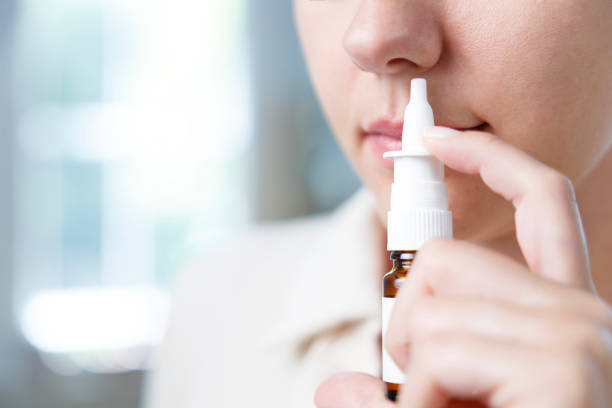USP Nasal Spray Droplet Size Distribution Testing
Inhalation and nasal products are designed to deliver active ingredients directly into the respiratory or nasal passages, providing rapid onset of action. The USP provides specific requirements for the droplet size distribution in nasal sprays as outlined in its monographs. Ensuring compliance with these standards is critical to ensuring product efficacy and patient safety.
The primary goal of USP Nasal Spray Droplet Size Distribution Testing is to evaluate the particle size distribution of the active ingredients within a nasal spray. This testing ensures that the spray delivers an appropriate number of particles in the aerosolized form, which can range from 10 microns (μm) up to about 50 μm, depending on the intended use and delivery mechanism.
The droplet size distribution is a critical factor as it influences the deposition pattern within the nasal passages. Smaller particles may deposit in the upper respiratory tract, while larger particles tend to deposit closer to the nostrils or be captured by the mucociliary system before reaching deeper tissues. Therefore, understanding and controlling this parameter helps ensure that the drug reaches its intended target site effectively.
The testing process involves several key steps: sampling, preparation of the sample for analysis, measurement using appropriate instrumentation, and finally, interpretation of results to determine compliance with USP standards. Sampling is typically done by collecting a series of samples over time to capture variability in droplet size distribution during manufacturing processes.
Preparation of the sample involves diluting or dispersing the nasal spray according to specific protocols provided by regulatory bodies such as the USP. This ensures that the sample accurately represents the product's performance under real-world conditions. Instrumentation used for this purpose includes laser diffraction analyzers, scanning electron microscopes (SEM), and image analysis software.
The measurement process itself is highly technical and involves careful calibration of instruments to ensure accuracy. The data collected provides detailed information about the distribution of droplet sizes within the sample, allowing for precise characterization and comparison against USP specifications.
Following measurement, the results are analyzed using statistical methods to determine whether they fall within acceptable limits set by the USP. Compliance with these standards is essential because it ensures that the nasal spray delivers an effective dose of medication directly into the desired area of the nasal passage or respiratory tract.
This testing contributes significantly to maintaining high quality in pharmaceutical products, particularly those intended for direct administration via inhalation or nasal routes. By adhering strictly to USP guidelines and performing thorough droplet size distribution tests, manufacturers can ensure their products meet stringent regulatory requirements and provide consistent efficacy across different batches of production.
Compliance with these standards not only enhances product reliability but also builds consumer trust in the integrity and effectiveness of pharmaceutical formulations. Therefore, it is crucial for quality managers, compliance officers, R&D engineers, and procurement teams to understand this testing process thoroughly so they can make informed decisions that support overall quality assurance efforts.
Industry Applications
| Application | Description |
|---|---|
| Quality Control | Ensures consistent droplet size distribution to maintain product quality and efficacy. |
| R&D Optimization | Aids in optimizing formulation parameters for improved drug delivery. |
| Compliance Assurance | Verifies adherence to USP standards, ensuring regulatory compliance and safety. |
| Patient Safety | Reduces risks associated with improper dosage or ineffective drug delivery. |
| Manufacturing Process Validation | Validates processes to ensure consistent product quality across batches. |
| Product Development | Assists in developing new formulations that meet stringent regulatory requirements. |
| Supply Chain Management | Ensures all suppliers provide products meeting specified droplet size distribution criteria. |
International Acceptance and Recognition
The USP Nasal Spray Droplet Size Distribution Testing is widely accepted internationally due to its stringent quality standards. Many countries have adopted the USP as a reference for pharmaceutical testing, recognizing its role in ensuring consistent product quality across borders.
ISO standards further reinforce this acceptance by aligning with international best practices. For instance, ISO 10993-18 specifies biocompatibility evaluation of medical devices intended to come into contact with the nasal mucosa or respiratory tract, which implicitly includes considerations for droplet size distribution.
ASTM E2764 provides guidelines for aerosol testing methods applicable to pharmaceutical products like nasal sprays. These international standards ensure that manufacturers adhere to global best practices and maintain consistent quality regardless of geographical location.
The recognition of USP standards extends beyond mere compliance; it fosters a culture of excellence in the development, production, and distribution of pharmaceuticals worldwide. This harmonization facilitates smoother operations for multinational companies operating across various regulatory environments.
Environmental and Sustainability Contributions
Inhalation and nasal products are designed with environmental sustainability in mind, particularly regarding waste generation and resource efficiency during use. Ensuring proper droplet size distribution through rigorous testing helps minimize unnecessary overspray or under-spray, which can lead to wasted resources.
By adhering strictly to USP guidelines, manufacturers reduce the likelihood of over-administered doses that could result in increased waste disposal challenges. This aligns with broader sustainability goals by promoting efficient use of active ingredients and reducing environmental impact.
The testing process itself also contributes indirectly to sustainability efforts by ensuring accurate formulation development and production practices. Efficient manufacturing processes lead to lower energy consumption, reduced chemical usage, and minimized emissions—all key factors in sustainable pharmaceutical manufacturing.





